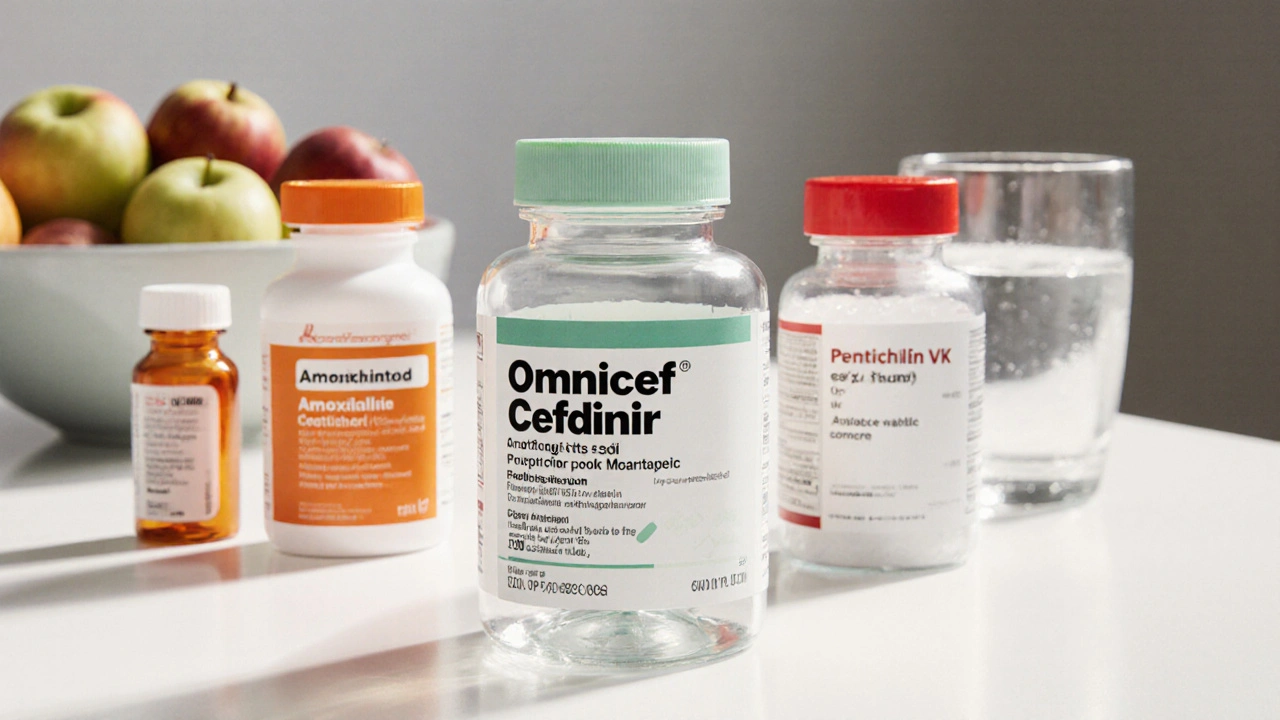Antibiotic Selection Tool
Which scenario matches your situation?
This tool recommends antibiotics based on common clinical scenarios described in the article.
If you’ve been handed a prescription for Omnicef and wonder whether another drug might suit you better, you’re not alone. Many patients ask: what makes this cephalosporin different, and when should I look at other options? This guide breaks down Omnicef’s profile, pits it against the most frequently prescribed alternatives, and equips you with a practical decision‑making framework.
Key Takeaways
- Omnicef (cefdinir) is a third‑generation oral cephalosporin with strong activity against many gram‑positive and some gram‑negative bacteria.
- It’s usually taken once or twice daily for 5‑10days, making adherence easier than some multi‑dose regimens.
- Common alternatives include amoxicillin, azithromycin, cefuroxime, clarithromycin, levofloxacin, and penicillinVK.
- Side‑effect profiles vary: Omnicef often causes yellow‑green stool, while macrolides tend to cause stomach upset and drug‑interaction risk.
- Choosing the right antibiotic hinges on infection type, bacterial resistance patterns, patient allergies, dosing convenience, and cost.
What Is Omnicef (Cefdinir)?
Cefdinir is a third‑generation oral cephalosporin marketed in many countries under the brand name Omnicef. It was approved by the FDA in 1991 and has since become a staple for treating community‑acquired respiratory infections, skin infections, and certain ear infections.

How Omnicef Works
Cefdinir belongs to the beta‑lactam class, meaning it attacks the bacterial cell wall. Specifically, it binds to penicillin‑binding proteins, halting the cross‑linking of peptidoglycan strands. Without a sturdy wall, bacteria burst under osmotic pressure. This mechanism makes it bactericidal and effective against organisms that produce beta‑lactamase enzymes, though not all.
When Doctors Prescribe Omnicef
Typical indications include:
- Acute bacterial sinusitis
- Pharyngitis/tonsillitis caused by susceptible streptococci
- Otitis media (especially in patients allergic to penicillin)
- Uncomplicated skin and soft‑tissue infections
- Community‑acquired pneumonia caused by Streptococcus pneumoniae or Haemophilus influenzae
If you have a penicillin allergy, Omnicef often serves as a safe substitute because of its distinct beta‑lactam ring structure, though cross‑reactivity can still occur in a small fraction of patients.
How Does Omnicef Stack Up Against Popular Alternatives?
Below is a side‑by‑side look at the most common oral antibiotics people compare with cefdinir. The table focuses on spectrum of activity, dosing convenience, typical uses, notable side effects, and average cost in Australia (2025).
| Antibiotic | Spectrum | Typical Dose & Duration | Common Indications | Key Side Effects | Average Cost (AUD) |
|---|---|---|---|---|---|
| Cefdinir | Gram‑positive + limited gram‑negative (incl. H. influenzae) | 300mg PO BID for 5‑10days | Sinusitis, otitis media, skin infections | Yellow‑green stool, mild GI upset | $15-$25 for 10‑day course |
| Amoxicillin | Broad gram‑positive, limited gram‑negative | 500mg PO TID for 7‑10days | Strep throat, otitis media, dental infections | Rash, diarrhea | $8-$12 |
| Azithromycin | Gram‑positive, atypicals, some gram‑negative | 500mg PO daily for 3days (Z‑pack) | Chlamydia, Mycoplasma, atypical pneumonia | QT prolongation, GI upset | $20-$30 |
| Cefuroxime | Second‑gen cephalosporin - broader gram‑negative | 250mg PO BID for 7‑10days | UTIs, sinusitis, bronchitis | Diarrhea, rash | $18-$28 |
| Clarithromycin | Macrolide - good against atypicals, some gram‑positive | 250mg PO BID for 7‑14days | Helicobacter pylori, atypical pneumonia | Metallic taste, drug interactions | $22-$35 |
| Levofloxacin | Fluoroquinolone - broad gram‑negative & gram‑positive | 500mg PO daily for 5‑7days | Complicated UTIs, community pneumonia | Tendonitis, CNS effects | $30-$45 |
| Penicillin VK | Classic narrow‑spectrum gram‑positive | 500mg PO QID for 10days | Strep throat, syphilis, dental prophylaxis | Allergic rash, anaphylaxis (rare) | $5-$9 |
Pros and Cons of Omnicef
Every drug has trade‑offs. Below is a quick pros‑cons list that helps you weigh Omnicef against the table above.
- Pros:
- Once‑ or twice‑daily dosing improves adherence.
- Effective against beta‑lactamase‑producing H. influenzae, a common cause of sinusitis.
- Relatively low risk of serious drug‑drug interactions.
- Cons:
- Can turn stool a bright orange‑yellow, which scares some patients.
- Not as potent against atypical organisms (e.g., Mycoplasma).
- Cost is higher than generic amoxicillin or penicillin.
Choosing the Right Antibiotic - A Simple Decision Guide
Instead of memorizing every antibiotic, ask yourself three questions before you or your doctor pick a drug:
- What pathogen is likely? If you suspect a typical gram‑positive strep infection, amoxicillin or penicillin are usually first‑line. For suspected beta‑lactamase‑producing gram‑negative microbes, cefdinir or cefuroxime become attractive.
- Do you have allergies or risk factors? A documented penicillin allergy pushes clinicians toward a cephalosporin like cefdinir (if the allergy isn’t severe) or a macrolide like azithromycin.
- How important is dosing convenience? Short courses (e.g., azithromycin’s 3‑day Z‑pack) beat longer regimens for busy patients, but convenience should never sacrifice efficacy.
Apply the answers to the matrix below to see which class fits your situation best.
| Scenario | Best First‑Line Choice | Why? |
|---|---|---|
| Uncomplicated strep throat, no allergy | Amoxicillin | Proven efficacy, cheap, narrow spectrum |
| Sinusitis with suspected beta‑lactamase H. influenzae | Omnicef (Cefdinir) | Effective against beta‑lactamase, convenient dosing |
| Patient allergic to penicillin (mild rash) | Cefdinir or Azithromycin | Cefdinir offers similar spectrum; azithromycin avoids beta‑lactam class altogether. |
| Suspected atypical pneumonia (e.g., Mycoplasma) | Azithromycin or Clarithromycin | Macrolides target atypical organisms better than cephalosporins. |
| Complicated urinary tract infection | Levofloxacin | Broad gram‑negative coverage, excellent tissue penetration. |
Frequently Asked Questions
Can I take Omnicef if I’m allergic to penicillin?
Mild penicillin allergies (rash without anaphylaxis) often allow the use of cefdinir because cross‑reactivity occurs in less than 5% of cases. However, severe IgE‑mediated reactions should be discussed with a doctor before starting any beta‑lactam.
Why does my stool turn orange after taking Omnicef?
Cefdinir contains an iron‑based dye that can color stool bright yellow‑green. It’s harmless and fades after the medication stops.
Is a 5‑day course of Omnicef as effective as a 10‑day course?
For uncomplicated sinusitis, studies from 2023‑2024 show that 5‑day cefdinir regimens achieve cure rates comparable to 10‑day courses, provided the pathogen is susceptible.
Can I switch from amoxicillin to Omnicef midway through treatment?
Switching is possible if a culture shows a beta‑lactamase‑producing organism or if you develop a rash. Your prescriber should confirm the new dosage and total treatment length.
Are there any foods or drinks I should avoid while on Omnicef?
There are no strict dietary restrictions, but taking the capsule with a full glass of water reduces the chance of gastrointestinal upset. Avoid antacids within two hours of the dose if you have a sensitive stomach.



Comments
When you read about Omnicef, the first thing that hits you is how many options doctors have these days. I once had a sinus infection and was prescribed amoxicillin, but the rash forced a switch to cefdinir. The dosing felt like a miracle – just once a day for a week. My stool turned a weird color, but it cleared up quickly. It’s funny how a tiny pill can cause such drama.
When looking at the table, the cost differences jump out immediately. Amoxicillin is cheap, while levofloxacin can break the bank. For most people, the price matters just as much as the spectrum. It’s nice to have a clear visual to compare. Staying within budget while getting effective treatment is key.
When scholars dissect antibiotic guidelines, they often overlook the subtle pharmacokinetic nuances that define clinical success. The article presents a tidy matrix, yet ignores the evolving beta‑lactamase landscape that renders cefdinir less reliable in certain regions. One must consider local antibiograms before blindly trusting a generic recommendation. Moreover, the side‑effect profile of macrolides, though dismissed, can precipitate cardiac events in susceptible patients. Thus, the so‑called “first‑line” label deserves a more critical lens.
Honestly, Shawn, you’re tossing around big words like “pharmacokinetic nuances” while forgetting that most primary‑care docs need a simple rule‑of‑thumb. The local antibiogram is indeed important, but the article already hints at it in the decision matrix. Also, the claim about macrolide‑induced cardiac events is a bit over‑dramatic for the average patient – most don’t have underlying QT issues. Let’s keep the discussion grounded, shall we?
When I first saw the bright orange stool warning, I thought the world was ending, but then I remembered that many antibiotics come with quirky side‑effects. The dramatic flair of the guide actually helped me remember the key points – dosing convenience, cost, and those colorful warnings. It’s like a mini‑drama playing out in my medicine cabinet. Kudos to the author for making the science feel alive.
When guiding someone through antibiotic choices, it’s helpful to break down the information into bite‑size pieces. First, identify the likely pathogen; second, match it with the narrowest effective agent; third, weigh cost and dosing frequency. In the case of uncomplicated sinusitis, cefdinir offers a good balance of spectrum and convenience, but amoxicillin remains the cheaper alternative if the organism is susceptible. Keeping the regimen short reduces resistance pressure, which benefits everyone.
When you think about it, the real winner here is the three‑day azithromycin pack – who wants to pop pills for ten days? The compliance boost is huge, especially for busy folks. Sure, the cost is higher, but the trade‑off in convenience often justifies it. Plus, the macrolide covers atypicals that cefdinir can’t touch.
When patients skip the fine print, they end up in trouble and that’s just not okay. The guide does a decent job, but we need to stress that self‑diagnosing and grabbing the cheapest pill isn’t responsible. Every antibiotic course should be a pact with your doctor, respecting the science and the community’s fight against resistance.
When you dissect the antimicrobial stewardship paradigm you see that the article’s heuristic aligns with the pharmacodynamic targets of time‑dependent killers like beta‑lactams and concentration‑dependent agents such as fluoroquinolones however the omission of MIC breakpoints limits its translational utility for clinicians operating in high‑risk ecosystems
When I sit down to compare oral antibiotics, I start with the fundamental principle of matching drug to pathogen, which is the cornerstone of rational therapy. The guide correctly highlights that cefdinir sits in the third‑generation cephalosporin class, offering a broader gram‑negative reach than amoxicillin, yet it still retains decent gram‑positive activity. The dosing convenience of once or twice daily is a practical advantage, especially for patients who struggle with complex regimens. However, the bright yellow‑green stool is not just a cosmetic issue; it can alarm patients and affect adherence if they are not counseled properly. Cost analysis shows that while cefdinir is more expensive than generic penicillins, it remains affordable in most insurance plans, and the price gap narrows when you consider the potential need for a second‑line agent if amoxicillin fails. The side‑effect profile, dominated by mild gastrointestinal upset, is generally well tolerated, but clinicians should remain vigilant for Clostridioides difficile risk, particularly in older adults. In terms of resistance, local antibiograms are indispensable; regions with high rates of beta‑lactamase‑producing Haemophilus may still see reduced efficacy of cefdinir, prompting a switch to a beta‑lactamase inhibitor combination. The table in the article does a solid job of summarizing key metrics, but it could be enhanced by including the specific MIC breakpoints for common isolates. Regarding atypical pathogens, the guide rightly directs readers toward macrolides, as cephalosporins lack activity against Mycoplasma and Chlamydia species. The inclusion of fluoroquinolones for complicated urinary tract infections reflects current practice, yet the discussion should also acknowledge the FDA warnings about tendon toxicity and neuropsychiatric effects. Patient education plays a pivotal role; explaining the importance of completing the full course, even if symptoms improve early, helps curb resistance development. Moreover, the decision matrix could benefit from a patient‑centered factor column, such as pregnancy safety, which influences drug choice significantly. For allergic patients, the cross‑reactivity of cefdinir with penicillins remains low, but a detailed allergy history is essential before prescribing. Finally, while the guide is comprehensive, clinicians should integrate it with clinical judgment, taking into account comorbidities, drug interactions, and patient preferences to arrive at the optimal therapeutic plan.
When you write “cefdinir” you should italicize it for consistency.